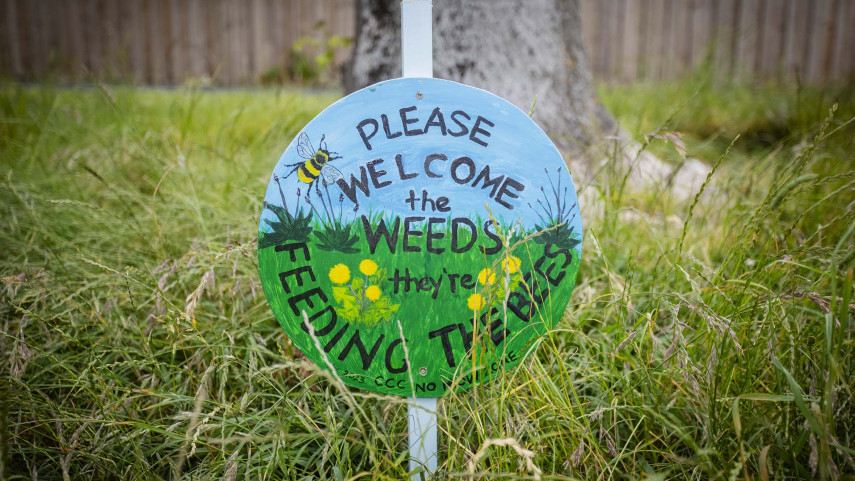
Wild nature blooms at community park

Share this story
Wildflowers, fruit trees and hand-painted signs are helping to brighten up Addington’s Simeon Park in a bid to create a more welcoming and diverse space, as well as help reduce the impact on the environment.
A collaboration between Christchurch City Council Parks and a local volunteer group has seen no-mow and low-mow areas and a small orchard established within the park with the aim of growing a ‘food forest’ over time.
It’s the brainchild of the Simeon Park Community Group, who began with a presentation to their local Community Board.
“Through that process we met with our local Community Partnership Rangers, Holly Whitaker and Annaliese Caukwell-Mills,” says group spokesperson Rebecca.
“Our group was especially keen on reducing the large amount of mowing done at the park, which was such a waste of energy. We had on site meetings to discuss this project and agreed to how to make it happen. It’s taken flexible thinking and kōrero from both sides. The Council understood how important it was for our community group to be reducing emissions.”
Together, they worked on developing no-mow and low-mow areas within the park, planting daffodils, natives, and some fruiting trees, and putting up signage to help people understand it was a community project.
The no-mow and low-mow zones provide “heaps” of benefits.
“The longer the stalks the more carbon is drawn down, less mowing means less energy wasted. I’ve also been told that dogs love running through the long grass,” says Rebecca.
“The climate is changing rapidly, so we’ll need to make rapid changes too. Enhancing the biodiversity and increasing the shade of a local park is one of many ways we can influence our local community and create resilience.”
“As the climate worsens, we expect to see more local developments like this and it’d be good if this happened sooner rather than later, so we are super encouraging of other parks developing in this way,” she says.
She says seed heads provide food for birds and homes for insects, while bees love the dandelions and clover flowers.
“Who knows, maybe some skinks will return to the park. That would be awesome!”
“Having beautiful local spaces which provide shade, kai and sanctuaries for people and nature will help us all find deeper relationships with each other and the whenua,” Rebecca says.
“Community groups are good ways to make friends and do your bit for the climate too. I’d encourage everyone to do their bit, to reduce emissions and to help our environment, whatever inspires them.”
Meanwhile the group hopes the orchard will transition to a food forest, over time, has installed a nature play log and has been involved in the Council’s wildflower programme which has had overwhelmingly positive feedback from the community.
“There is so much we can do, with the Council’s help, a small amount of capital investment and the mahi of volunteers. Anyone can do the same thing, we are just ordinary people getting together to care for nature/Papatūānuku, so she can care for us,” she says.
“Kaitiaki of local parks can make a big difference and community groups can develop them to suit their unique area, if they work with Council staff and develop a trusting relationship. The park rangers have been key to that, and really get what we are trying to achieve.”
Community Parks Manager Al Hardy says they welcome local initiatives like this.
“Working with local groups to share knowledge, advice and resources brings real benefits. The community gets to have input into their local park and that involvement means the space is better utilised and more vibrant.”
To find out more, join the their Facebook group: Simeon Park Community Group.
